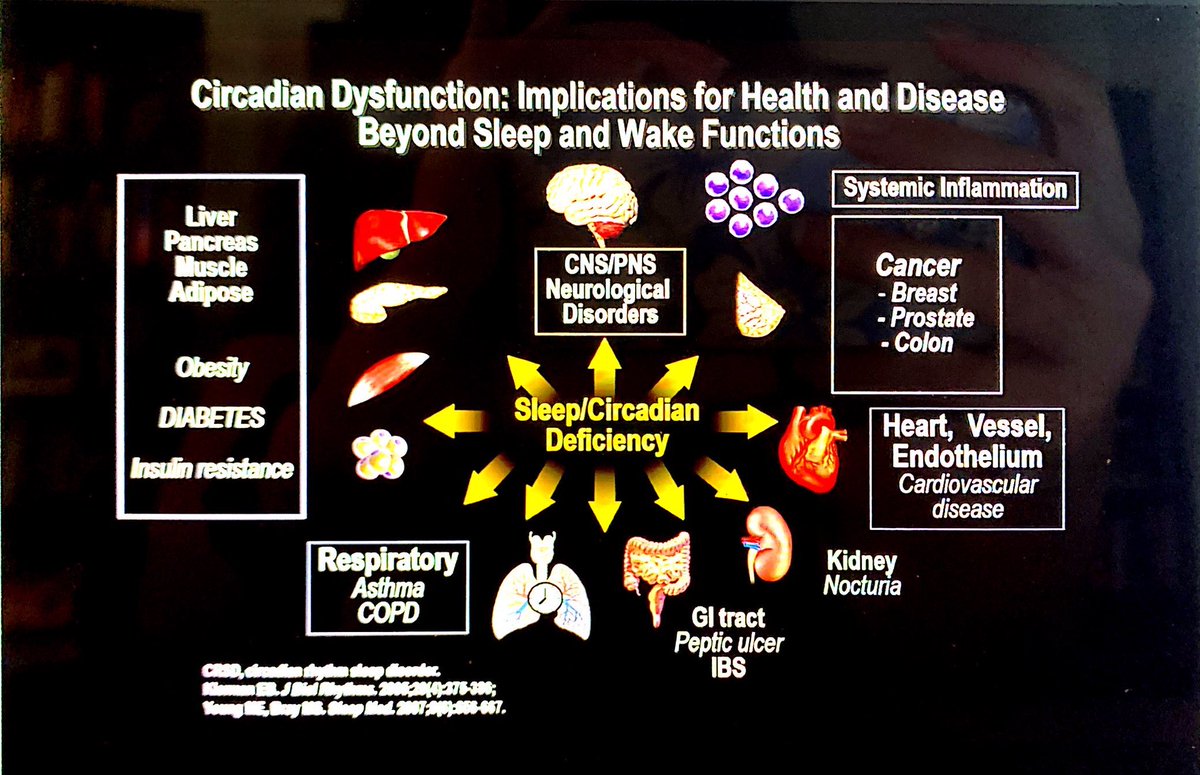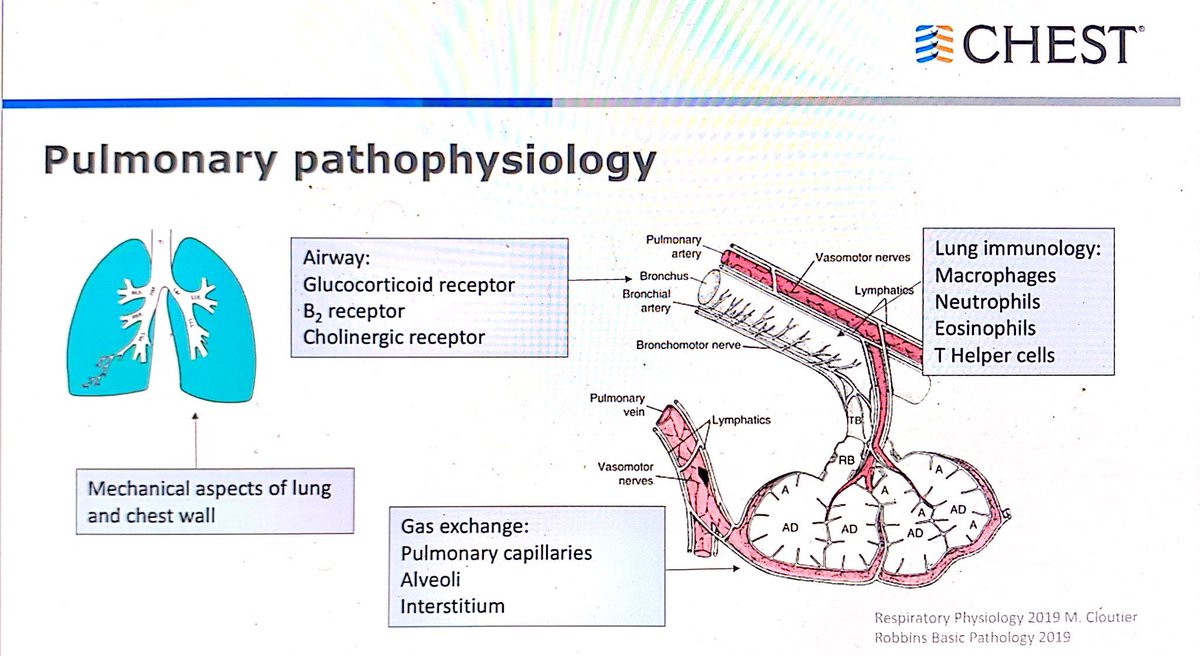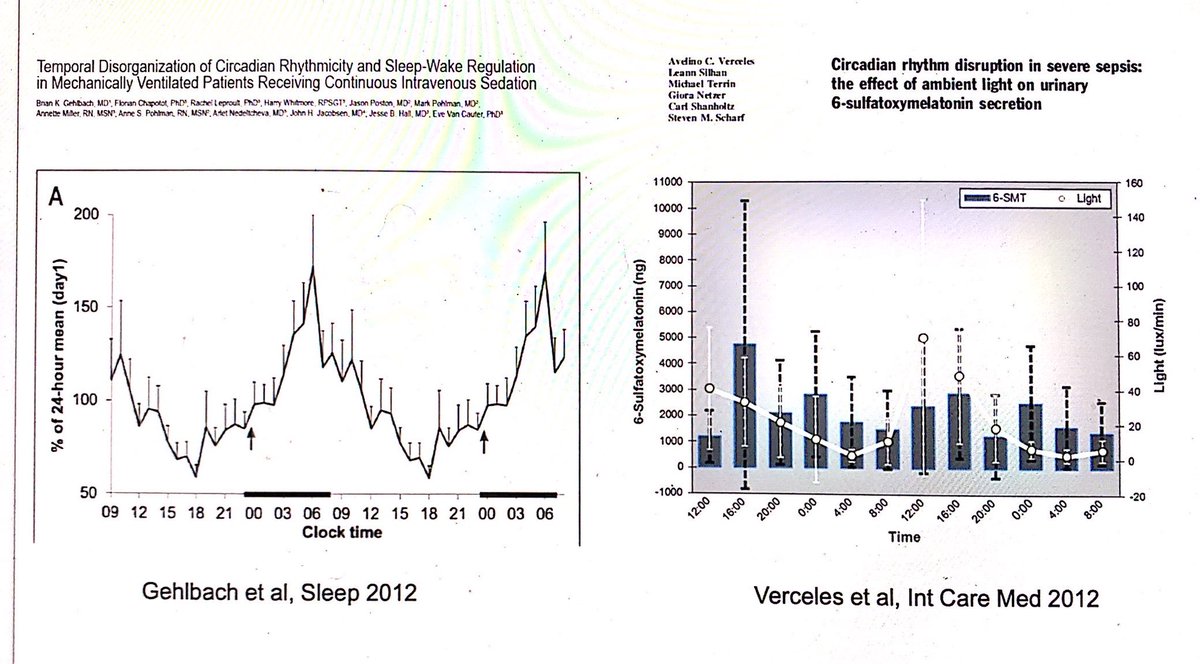
My last tweet-ucation session of day is “Circadian Rhythms for the Chest Clinician: It’s About Time”! #CHEST2020
Our first session is "Circadian Rhythms: Mechanisms and Role in Health and Disease” with Dr. Phyllis Zee! #CHEST2020 

One of the most prominent changes in our physical environment is the rotation of the Earth, and our body has to adjust to that. Our BP, platelets, temperature, alertness, and more vary at different times of the day. #CHEST2020 

History of our understanding of clocks #CHEST2020 

How quickly proteins are made or degenerated determines how fast an animal's cellular clock ticks. #CHEST2020 

Clocks are integrated into every cell and system of our body. Genes are rhythmically expressed in different tissues and there is internal synchronization between the organs and cells. #CHEST2020 



Circadian dysfunction has broad implications for our health and disease! #CHEST2020 

The photoreceptor for circadian rhythm entrainment is located in the retinal ganglion cells. #CHEST2020
The strongest stimuli for our wake-sleep cycle is light. Food, social/physical activity, and melatonin also can entrain the cycle. #CHEST2020 

There are different cycles that can be manipulated that play into our overall clock. #CHEST2020 

How can you apply the circadian system to medicine? #CHEST2020 

This summarizes the broad implications for circadian rhythms across disease expression and treatments. #CHEST2020 

The next session is "Circadian Rhythms in Pulmonary Disease" with Dr. Garbo Mak! #CHEST2020
Overview of pulmonary physiology. #CHEST2020 

Nocturnal asthma has an established relationship with the circadian rhythm. #CHEST2020 

Lung function follows circadian patterns with best function at 4pm and worst at 4am. The peak to trough swings in peak flow are greater in patients with asthma. #CHEST2020 

Airway inflammation also follows circadian patterns. #CHEST2020 

In mouse models of allergic inflammation the deletion of the clock gene (BMAL1) led to worsened airway remodeling. #CHEST2020 

The premise of chronotherapy in asthma is to decrease side effects and maximize efficacy of medicines. Single doses of inhaled steroids are just as effective as BID dosing. #CHEST2020 

There is also a relationship with COPD and circadian rhythms. #CHEST2020 

Clock genes and COPD #CHEST2020 

COPD and nocturnal disturbances. Nocturnal symptoms are common in COPD, as are sleep-related breathing disorders. #CHEST2020 

Components of the innate and adaptive immune system have circadian rhythms, and in mice pneumococcal pneumonia severity varied with time. #CHEST2020 

Viral pneumonia is also affected by circadian rhythms. We should consider how this may play into COVID as well. #CHEST2020 

Key points #CHEST2020 

The next session is "Circadian Rhythms in Critical Illness" with Dr. Margaret Pisani. #CHEST2020
There is an interplay between sleep disruption, delirium, and circadian abnormalities. #CHEST2020 

The PADIS guidelines say that there is an association between sleep quality and delirium, and the effects on long-term outcomes are unknown. #CHEST2020 

There are several measures of circadian rhythm (both physiologic and biomarkers). #CHEST2020 

Studies demonstrate disturbance of the circadian rhythm in critical illness. #CHEST2020 

Activity levels have been found to be lower in critically ill patients. #CHEST2020 

These studies looked at circadian rhythm disruption in critically ill patients. The 1st showed that there is a shifted melatonin onset in patients on continuous sedation. The 2nd showed that in severe sepsis the patients had a phase delay. #CHEST2020 

What contributes to circadian disruption in the ICU? #CHEST2020 

Many medications we use in the ICU can affect melatonin levels. #CHEST2020 

Light is the main synchronizer for the circadian rhythm, and light levels in the ICU often conflict with natural light levels. #CHEST2020 

Factors that influence light by the time of day include bright lights being on, television use, and window shades. #CHEST2020 

This study shows that melatonin levels were disrupted by different factors in critical illness. #CHEST2020 

This study looked at the effects of timed light exposure in critically ill patients. Timed light exposure helped to correct their cycle shift. #CHEST2020 

This study did not find a difference in the use of bright light to prevent delirium, but there were concerns that the light wasn't bright enough and that sedated patients had their eyes closed. #CHEST2020 

Early mobilization may help maintain a normal circadian rhythm. #CHEST2020 

Consider a circadian rhythm chronobundle. #CHEST2020 

Conclusions #CHEST2020 

Our last session is "Circadian Rhythms and Cancer" with Dr. Dave Balachandran! #CHEST2020
Shift work that involves circadian disruption is thought to be carcinogenic to humans! #CHEST2020 

This meta-analysis shows that there is a slightly increased risk of breast cancer. #CHEST2020 

This study showed that there was a subset of women with a higher risk for breast cancer. There is similar data in colorectal cancer and prostate cancer. #CHEST2020 

Many of the signals that can lead to cancer have alignment with circadian rhythms, including cell-cycle checkpoints! #CHEST2020 

Cancer chronotherapy can be used to try to time chemotherapy to target times when cancer cells are regulating. Cancer chronotherapy may help decrease stomatitis! #CHEST2020 



There is also good data to suggest that the clock genes themselves can be possible targets for therapy. #CHEST2020 

Cancer processes and treatment lead to a dysregulated circadian rhythm. #CHEST2020 

This study looked at patients undergoing chemo and found that fatigue was correlated with changes in circadian rhythm. #CHEST2020 

Circadian disruption also seems to affect cancer survival with more disrupted rhythms being associated with worse survival! #CHEST2020 

Chronorehabilitation involves manipulating behavioral and pharmacological factors to improve circadian rhythms, sleep quality, and cancer-related symptoms. #CHEST2020 

Conclusions #CHEST2020 

And a special thank you to all of our excellent speakers!!! #CHEST2020
• • •
Missing some Tweet in this thread? You can try to
force a refresh













